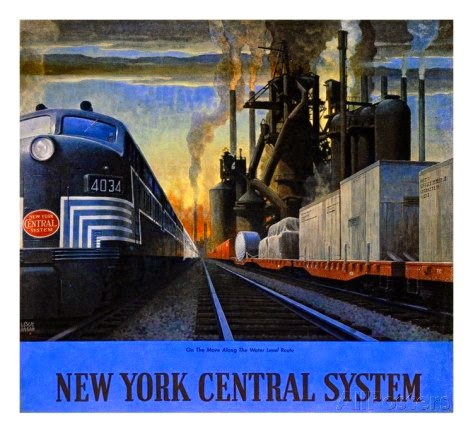During the 1920s, the interurban Chicago, South Shore, and South Bend
Railroad, best known simply as the South Shore, hired numerous poster
artists to advertise its trains. Of these, the one who eventually became
most famous is Leslie Ragan, whose later work for the New York Central
and Budd epitomized the art of mid-twentieth-century rail paintings. Leslie was born in Woodbine, Iowa in 1897. He studied at the Cumming School of Art in Des Moines, and later, at The Art Institute of Chicago. He died in 1972. Text and photos courtesy of Streamliner Memories.
Most of these poster artists were born in the 1880s and 1890's, the only exceptions being some of the contributors to the Southern Pacific posters. I suspect the reason for this seeming coincidence is that these artists happened to come of age at a time when printing technologies had advanced enough to make it economically feasible to print larger numbers of multi-colored posters.
In an article about the South Shore’s posters, artist J. J. Sadelmeier describes how posters were printed. “Back then, the lithography process used to (re)produce these posters involved taking and artists artwork (in this case 15″X22″ water-based gouache paintings on board) and translating the designs to separate lithography stones–one for each color. The lithographer’s objective was to faithfully reproduce everything from color to texture and then register all the separate color levels during the printing process to replicate the original design. The final image was also enlarged to the standard 27″X41″ (one sheet) poster size for exterior display on the train platforms, etc.”
Ultimately, this process was replaced by modern four-color printing, which allows the reproduction of just about any color with just four passes. Four-color printing also made possible posters from photographs, which put most poster-making artists out of business.
The chief limitation of the lithographic process is that it required a separate print run for each and every color on the poster–and each print run is another opportunity to mess up. This is why so many artists made designs that were flat even though their paintings that weren’t intended to become posters tended to be much more detailed. Even these South Shore posters, which are pretty flat, require four, five, or more print runs.
Leslie Ragan was younger than the 1880s artists, having been born in Iowa in 1897. His youth allowed his career to extend well into the streamlined age, though most of his post-war work was published as magazine ads rather than posters. His work for The New York Central Railroad has become iconic in American transportation art but I really love the warmth and 1920's feel of his earlier work for The South Shore Line. They remind me very much of the woodcut prints of Hoosier and Santa Fe artist Gustav Baumann.
Here are a few examples of the work Ragan produced for The New York Central Railroad.
Most of these poster artists were born in the 1880s and 1890's, the only exceptions being some of the contributors to the Southern Pacific posters. I suspect the reason for this seeming coincidence is that these artists happened to come of age at a time when printing technologies had advanced enough to make it economically feasible to print larger numbers of multi-colored posters.
In an article about the South Shore’s posters, artist J. J. Sadelmeier describes how posters were printed. “Back then, the lithography process used to (re)produce these posters involved taking and artists artwork (in this case 15″X22″ water-based gouache paintings on board) and translating the designs to separate lithography stones–one for each color. The lithographer’s objective was to faithfully reproduce everything from color to texture and then register all the separate color levels during the printing process to replicate the original design. The final image was also enlarged to the standard 27″X41″ (one sheet) poster size for exterior display on the train platforms, etc.”
Ultimately, this process was replaced by modern four-color printing, which allows the reproduction of just about any color with just four passes. Four-color printing also made possible posters from photographs, which put most poster-making artists out of business.
The chief limitation of the lithographic process is that it required a separate print run for each and every color on the poster–and each print run is another opportunity to mess up. This is why so many artists made designs that were flat even though their paintings that weren’t intended to become posters tended to be much more detailed. Even these South Shore posters, which are pretty flat, require four, five, or more print runs.
Leslie Ragan was younger than the 1880s artists, having been born in Iowa in 1897. His youth allowed his career to extend well into the streamlined age, though most of his post-war work was published as magazine ads rather than posters. His work for The New York Central Railroad has become iconic in American transportation art but I really love the warmth and 1920's feel of his earlier work for The South Shore Line. They remind me very much of the woodcut prints of Hoosier and Santa Fe artist Gustav Baumann.
Here are a few examples of the work Ragan produced for The New York Central Railroad.









No comments:
Post a Comment